A Look At Triple-GPU Performance And Multi-GPU Scaling, Part 1
by Ryan Smith on April 3, 2011 7:00 AM ESTCrysis, BattleForge, Metro 2033, and HAWX
For the sake of completeness we have included both 2560x1600 and 1920x1200 results in our charts. However with current GPU performance a triple-GPU setup only makes sense at 2560, so that’s the resolution we’re going to be focusing on for commentary and scaling purposes.
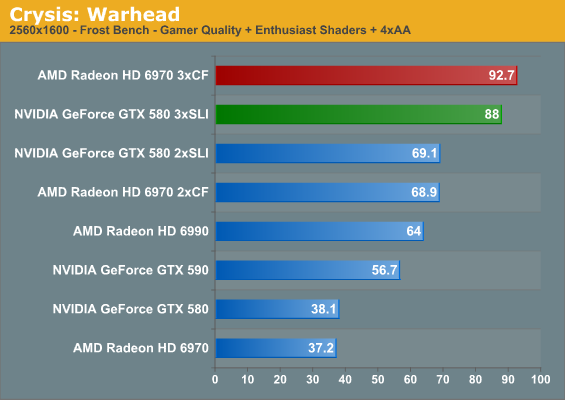
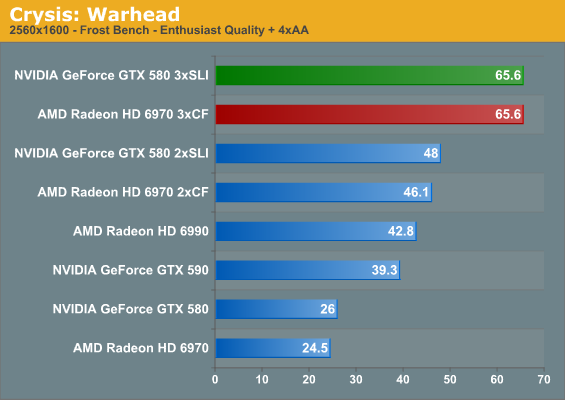


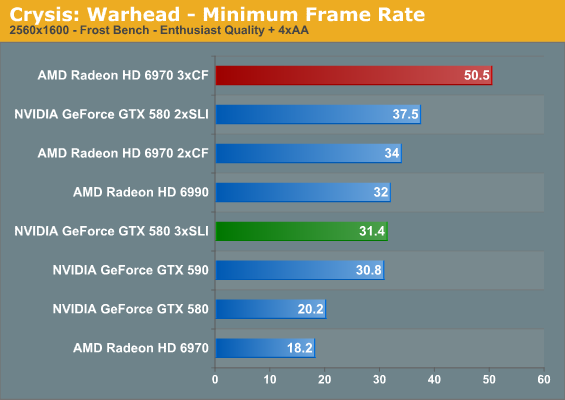

As we normally turn to Crysis as our first benchmark it ends up being quite amusing when we have a rather exact tie on our hands. The triple GTX 580 setup ends up exactly tying the triple 6970 setup at 2560x1600 with full enthusiast settings at 65.6fps. This is quite an appropriate allegory for AMD and NVIDIA’s relative performance as of late, as the two are normally very close when it comes to cards at the same price. It’s also probably not the best start for the triple GTX 580 though, as it means NVIDIA’s lead at one and two cards has melted away by the 3rd.
We have however finally established what it takes to play Crysis at full resolution on a single monitor with every setting turned up – it takes no fewer than three GPUs to do the job. Given traditional GPU performance growth curves, it should be possible to do this on a single GPU by early 2014 or so, only some 7 years after the release of Crysis: Warhead. If you want SSAA though, you may as well throw in another few years.
Moving on, it’s interesting to note that while we had a tie at 2560 with Enthusiast settings for the average framerate, the same cannot be said of the minimums. At 2560, no matter the quality, AMD has a distinct edge in the minimum framerate. This is particularly pronounced at 2560E, where moving from two to three GPUs causes a drop in the framerate on the GTX 580. This is probably a result of the differences in the cards’ memory capacity – additional GPUs require additional memory, and it seems the GTX 580 and its 1.5GB has reached its limit. We never seriously imagined we’d find a notable difference between 1.5GB and 2GB at this point in time, but here we are.
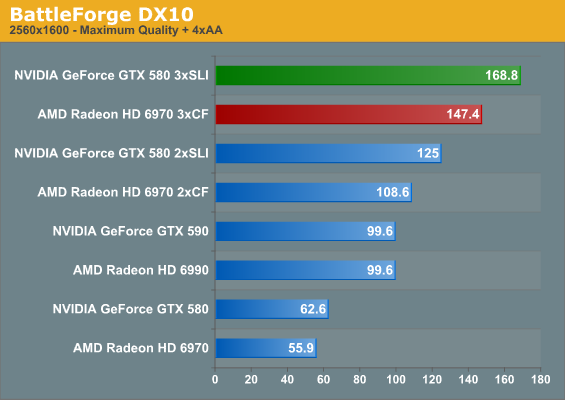
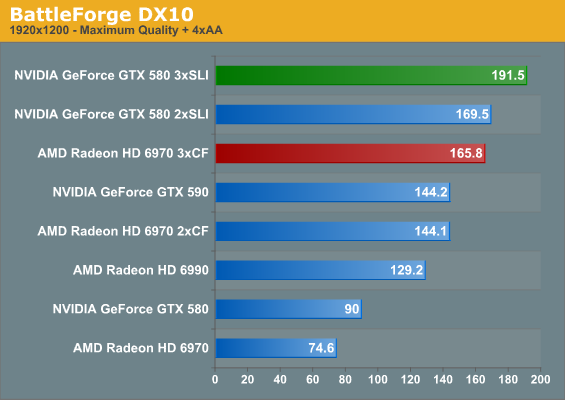
BattleForge is a shader-bound game that normally favors NVIDIA, and this doesn’t change with three GPUs. However even though it’s one of our more intensive games, three GPUs is simply overkill for one monitor.

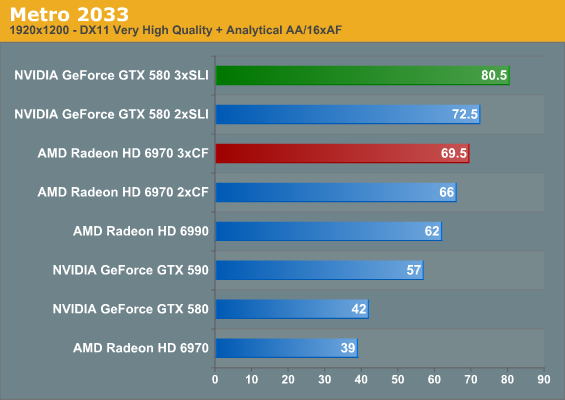
Metro 2033 is the only other title in our current lineup that can challenge Crysis for the title of the most demanding game, and here that’s a bout it would win. Even with three GPUs we can’t crack 60fps, and we still haven’t enabled a few extra features such as Depth of Field. The 6970 and GTX 580 are normally close with one and two GPUs, and we see that relationship extend to three GPUs. The triple GTX 580 setup has the lead by under 2fps, but it’s not the lead one normally expects from the GTX 580.
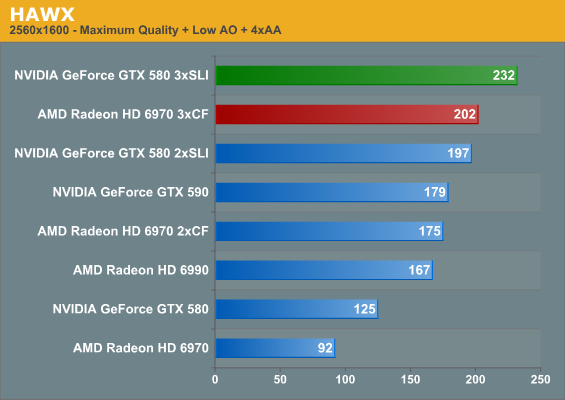

Our next game is HAWX, a title that shifts us towards games that are CPU bound. Even with that it’s actually one of the most electrically demanding games in our test suite, which is why we use it as a backup for our power/temperature/noise testing. Here we see both the triple GTX 580 and triple 6970 crack 200fps at 2560, with the GTX 580 taking top honors.
| Radeon HD 6970 | GeForce GTX 580 | |||||
| GPUs | 1->2 | 2->3 | 1->3 | 1->2 | 2->3 | 1->3 |
| Crysis G+E Avg |
185%
|
134%
|
249%
|
181%
|
127%
|
230%
|
| Crysis E |
188%
|
142%
|
268%
|
184%
|
136%
|
252%
|
| Crysis G+E Min |
191%
|
141%
|
270%
|
181%
|
116%
|
212%
|
| Crysis E Min |
186%
|
148%
|
277%
|
185%
|
83%
|
155%
|
| BattleForge |
194%
|
135%
|
263%
|
199%
|
135%
|
269%
|
| Metro 2033 |
180%
|
117%
|
212%
|
163%
|
124%
|
202%
|
| HAWX |
190%
|
115%
|
219%
|
157%
|
117%
|
185%
|
Having taken a look at raw performance, what does the scaling situation look like? All together it’s very good. For a dual-GPU configuration the weakest game for both AMD and NVIDIA is Metro 2033, where AMD gets 180% while NVIDIA manages 163% a single video card’s performance respectively. At the other end, NVIDIA manages almost perfect scaling for BattleForge at 199%, while AMD’s best showing is in the same game at 194%.
Adding in a 3rd GPU significantly shakes things up however. The best case scenario for going from two GPUs to three GPUs is 150%, which appears to be a harder target to reach. At 142% under Crysis with Enthusiast settings AMD does quite well, which is why they close the overall performance gap there. NVIDIA doesn’t do as quite well however, managing 136%. The weakest for both meanwhile is HAWX, which is what we’d expect for a game passing 200fps and almost assuredly running straight into a CPU bottleneck.
The Crysis minimum framerate gives us a moment’s pause though. AMD gets almost perfect scaling moving from two to three GPUs when it comes to minimum framerates in Crysis, meanwhile NVIDIA ends up losing performance here with Enthusiast settings. This is likely not a story of GPU scaling and more a story about GPU memory, but regardless the outcome is a definite hit in performance. Thus while minimum framerate scaling from one to two GPUs is rather close between NVIDIA and AMD with full enthusiast settings and slightly in AMD’s favor with gamer + enthusiast, AMD has a definite advantage going from two to three GPUs all of the time out of this batch of games.
Sticking with average framerates and throwing out a clearly CPU limited HAWX, neither side seems to have a strong advantage moving from two GPUs to three GPUs; the average gain is 131%, or some 62% the theoretical maximum. AMD does have a slight edge here, but keep in mind we’re looking at percentages, so AMD’s edge is often a couple of frames per second at best.
Going from one GPU to two GPUs also gives AMD a minor advantage, with the average performance being 186% for for AMD versus 182% for NVIDIA. Much like we’ve seen in our individual GPU reviews though, this almost constantly flip-flops based on the game being tested, which is why in the end the average gains are so close.










97 Comments
View All Comments
Ryan Smith - Sunday, April 3, 2011 - link
It took awhile, but we finally have 3 120Hz 1080P monitors on the way. So we'll be able to test Eyefinity, 3D Vision, and 3D Vision Surround; all of which have been neglected around here.Kaboose - Sunday, April 3, 2011 - link
I await these tests with breathless anticipation!veri745 - Sunday, April 3, 2011 - link
While this article was very well written, I think it is hardly worth it without the multi-monitor data. No-one (sane) is going to get 3x SLI/CF with a single monitor, so it's mostly irrelevant.The theoretical scaling comparison is interesting, but I'm a lot more interesting in the scaling at 3240x1920 or 5760x1080.
DanNeely - Sunday, April 3, 2011 - link
This is definitely a step in the right direction; but with other sites having 3x 1920x1200 or even 3x 2560x1600 test setups you'll still be playing catchup.RK7 - Sunday, April 3, 2011 - link
Finally! I created account just to write that comment :) That's what's missing and what definitely needs to be tested! Especially 3D Vision Surround - it's good to know if it's worth to put so much money into such setup, because single card may be on the edge of performance for modern games in stereoscopic mode with single monitor (good example is Metro 2033, that blows mind when in 3D, but I found with single GTX 570@900MHz is playable only at 1600x900 in 3D with maximum settings without DoF and AA, and even in such case it could drop for some action scenes with heavy lighting to ~12 fps...). So if three cards can achieve a good scaling and provide performance per monitor for 3 monitors setup close to single card for one monitor, then we're there and it's worth it definitely, but if numbers will be alike to those for single monitor scaling, then folks should be aware that there's no way for maximum visual quality gaming with current hardware on 3 monitors...Dustin Sklavos - Monday, April 4, 2011 - link
Not completely neglected. I've added triple-monitor surround testing to my boutique desktop reviews whenever able. :)Crazymech - Sunday, April 3, 2011 - link
I'm having my doubts about the capabilities of the 920 OC'd to 3.33 GHz matched up with 3 of the most powerful single GPUs.I understand straying away from SB because of the lanes, but you could at least have upped the OC to 3,8-4, which many people do (and I would think most that considers a tripple setup would use).
To underline it I point to the small differences between the 4.5 GHz 2600K and the lower overclocked one in the boutique builds reviews, with the highest clocked CPU coupled with weaker GPU's nipping at the heels of the more powerful GPU.
I suggest you at least experiment in a single test (say metro for example.. or battlefield) what a higher clocked X58 (or the 980's 6 cores) could do to the setup.
If I'm wrong, it would at least be good to know that.
BrightCandle - Sunday, April 3, 2011 - link
The fact that sandy Bridge has a PCI-E lanes problem is grounds for testing the impact.Still I would rather see the numbers on X58 and triple screen gaming before seeing the impact that SB makes the performance of SLI/CF setups.
Ryan Smith - Sunday, April 3, 2011 - link
For what it's worth, 3.33GHz is actually where this specific 920 tops out. It won't take 3.5GHz or higher, unfortunately.We'll ultimately upgrade our testbed to SNB - this article is the impetus for that - but that's not going to happen right away.
Crazymech - Monday, April 4, 2011 - link
It wont take 3.5? Really? That amazes me.Though very unfortunate for the purpose of this test.
The main focus is (of course) always on how the new GPU in relation to a standard CPU improves the framerate, but once in a while it would be interesting what different CPU's do to the GPU and FPS aswell. Like the old Doom III articles of showing Athlon dominating PenIV.
Thanks for the answer anyhows :).